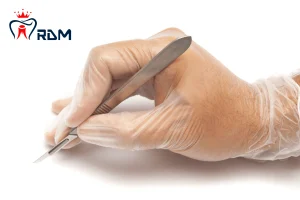Surgical blade holders are an indispensable tool in modern medicine, ensuring precision, safety, and efficiency in surgical procedures. These devices are designed to securely hold surgical blades in place, allowing surgeons to make accurate incisions and confidently perform delicate operations. In this blog post, we’ll take a closer look at the importance of surgical blade holders and how they’re revolutionizing surgical practices across the globe.
What is a Surgical Blade Holder?
A surgical blade holder is a device that holds a scalpel blade or other sharp instrument during surgical procedures. It provides stability and control, allowing the surgeon to make precise cuts and incisions with minimal risk of injury to surrounding tissues. The holder can be adjusted to different angles and positions, enabling the surgeon to access difficult areas and perform complex procedures efficiently.
Uses of Surgical Blade Holders
Surgical blade holders are used in a wide range of medical procedures, including:
1 – Neurosurgery: In neurosurgery, surgical blade holders play a crucial role in making precise incisions in the brain and spine. These incisions are critical for accessing specific areas of the nervous system, removing tumors, relieving pressure on compressed nerves, and repairing damaged blood vessels. The blade holder allows the surgeon to navigate through delicate neural tissue with minimal damage risk, ensuring optimal patient outcomes.
During neurosurgical procedures, the blade holder is typically attached to a surgical microscope, which enables the surgeon to visualize the operating site. The blade holder is then inserted into the incision site, and the scalpel blade is advanced and retracted carefully to create a precise cut. This process is repeated until the desired area is accessed or the procedure is completed.
2 – Ophthalmology: In ophthalmology, surgical blade holders are essential for eye incisions during various procedures. One of the most common applications is cataract surgery, where the blade holder creates a small incision in the cornea to remove the cloudy lens and replace it with an artificial intraocular lens. The blade holder is also used in glaucoma treatment to create incisions in the eye to improve drainage and reduce pressure in the eye.
During ophthalmic procedures, the blade holder is typically held in place by a stabilizing device, such as a lid speculum or a scleral hook. The surgeon then advances the scalpel blade to create a precise incision, avoiding damaging adjacent structures, such as the iris, retina, or optic nerve.
3 – Plastic surgery: In plastic surgery, surgical blade holders make precise incisions during various cosmetic procedures, such as facelifts, breast augmentations, and rhinoplasties. The blade holder provides the following:
- A stable platform for cutting.
- Allowing the surgeon to achieve smoothness.
- Even incisions that minimize scarring and promote faster healing times.
During plastic surgical procedures, the blade holder is typically attached to a surgical retractor or other stabilizing device, depending on the location and nature of the incision. The surgeon then advances the scalpel blade to create a precise incision to avoid damaging underlying tissues or structures.
4 – Cardiothoracic surgery: In cardiothoracic surgery, surgical blade holders play a critical role in making incisions in the chest and heart during various procedures, such as coronary artery bypass grafting and heart valve replacement. The blade holder enables the surgeon to access the heart and surrounding vessels safely and accurately, reducing the risk of complications and improving patient outcomes.
During cardiothoracic procedures, the blade holder is typically attached to a surgical retractor or stabilizer, which holds the rib cage open and provides exposure to the operating site. The surgeon then advances the scalpel blade to create a precise incision to avoid damaging any underlying structures, such as the heart, lungs, or major blood vessels.
5 – Gastrointestinal surgery: Surgical blade holders are commonly used to create precise incisions in the abdominal wall and facilitate access to the digestive organs. During a laparoscopic cholecystectomy, for example, the blade holder creates tiny incisions in the abdomen and dissects the gallbladder from the surrounding tissue.
The blade holder is also used to cut the cystic duct and artery, allowing the gallbladder to be removed through one of the small incisions. In addition to cholecystectomy, surgical blade holders may be used in other gastrointestinal procedures such as appendectomy, bowel resection, and gastric bypass surgery. Using surgical blade holders in these procedures allows the surgeon to operate with greater precision and control, reducing the risk of complications and promoting faster patient recovery times.
Benefits of Surgical Blade Holders
Surgical blade holders offer several benefits to patients and surgeons alike. Some of these benefits include:
- Enhanced accuracy: Surgical blade holders enable surgeons to make precise incisions, reducing the risk of complications and improving patient outcomes.
- Reduced trauma: By providing stability and control, surgical blade holders reduce the risk of accidental cuts or injuries to surrounding tissues.
- Shorter recovery time: Patients experience less tissue damage and trauma with precise incisions, resulting in shorter recovery times.
- Improved visibility: Surgical blade holders can be adjusted to provide optimal visibility, enabling the surgeon to see the area they are operating on clearly.
- Cost-effectiveness: Surgical blade holders are cost-effective compared to other surgical tools, making them a valuable investment for hospitals and clinics.
Conclusion
Surgical blade holders are essential in various medical procedures, offering numerous benefits to patients and surgeons. From neurosurgery to gastrointestinal surgery, their versatility and precision make them indispensable in modern medicine. As technology advances, we expect surgical blade holders to become even more sophisticated, enabling surgeons to perform complex procedures more accurately and safely.





